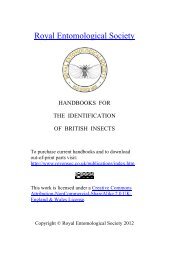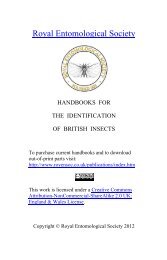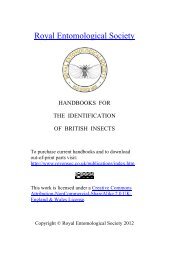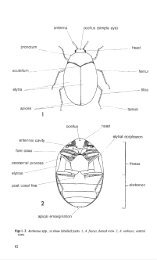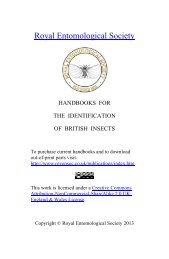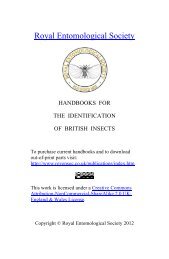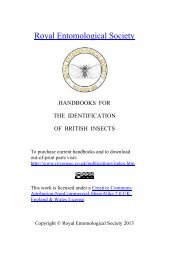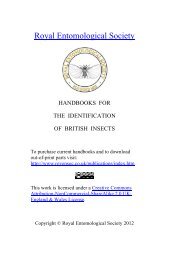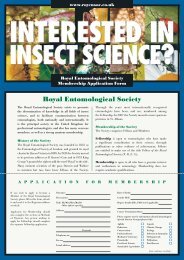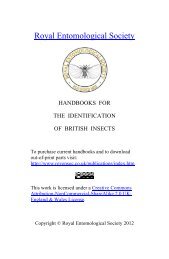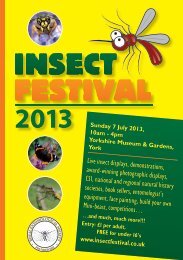Vol 10 Part 14. An introduction to the immature stages of British Flies ...
Vol 10 Part 14. An introduction to the immature stages of British Flies ...
Vol 10 Part 14. An introduction to the immature stages of British Flies ...
Create successful ePaper yourself
Turn your PDF publications into a flip-book with our unique Google optimized e-Paper software.
Larvae <strong>of</strong> six <strong>of</strong> <strong>the</strong> seven subfamilies (Manotinae not yet described) may be<br />
separated as follows (after Madwar 1937).<br />
Larva with one pair <strong>of</strong> thoracic and 8 pairs <strong>of</strong> abdominal spiracles (8th pair with horned<br />
prominences in Di<strong>to</strong>myia) (figs 79-80) . . . . . . . . . . . . Di<strong>to</strong>myiinae<br />
Larva with one pair <strong>of</strong> thoracic and at most 7 pairs <strong>of</strong> abdominal spiracles, or without<br />
spiracles (Keroplatinae) . . . . . . . . . . . . 2<br />
2 <strong>An</strong>tennae well developed, composed <strong>of</strong> three segments (fig. 81). Boli<strong>to</strong>philinae<br />
<strong>An</strong>tennae rudimentary, composed <strong>of</strong> one segment . 3<br />
3 Larva free; locomo<strong>to</strong>ry pads present (fig. 82) Myce<strong>to</strong>philinae<br />
Larva enclosed in slimy tube, or in web; pads absent 4<br />
4 Larva without spiracles, vermiform (worm-shaped) . Keroplatinae<br />
Larva with spiracles, not vermiform . . . . 5<br />
5 Larva peripneustic (fig. I) . . . . . . . . . most Sciophilinae<br />
Larva propneustic (fig. I) . . . . . . . . . . . . . . 6<br />
6 Epicranial plates meeting as usual on ventral surface (fig. 86) . . . . . . .<br />
. . . . . . . . . . . . . . . . (Genus Speolepta) Sciophilinae<br />
Epicranial plates not meeting on ventral surface . . . . Diadocidiinae<br />
The larvae <strong>of</strong>Myce<strong>to</strong>philidae are mostly found in <strong>the</strong> larger fungi and it is probable<br />
that even when found elsewhere <strong>the</strong> majority are feeding on micr<strong>of</strong>ungi or fungal<br />
hyphae.<br />
Chandler (in Stubbs & Chandler, 1978) lists fungus associations for 130 <strong>British</strong><br />
species <strong>of</strong> Myce<strong>to</strong>philidae and Hutson et al. (1980) give considerable information on<br />
life his<strong>to</strong>ries. Mad war (1937) and Las<strong>to</strong>vka ( 1971) describe some <strong>immature</strong> <strong>stages</strong>.<br />
There are three recognisable <strong>stages</strong> in <strong>the</strong> development <strong>of</strong> a s<strong>of</strong>t fungal fruiting body<br />
(sporophora): I, fresh with no signs <strong>of</strong> decay; 2, decaying through age and damage<br />
(mostly by fungivores); 3, semi-liquid, advanced state <strong>of</strong> decay (some <strong>to</strong>ugher fungi<br />
desiccate ra<strong>the</strong>r than rot and are unsuitable for fungus-gnats).<br />
Most myce<strong>to</strong>philids attack <strong>the</strong> first two <strong>stages</strong> but some species will continue <strong>to</strong><br />
develop in <strong>the</strong> last stage <strong>of</strong> almost any rotting fungus (e.g. Myce<strong>to</strong>philafungorum De<br />
Geer). O<strong>the</strong>r habits and habitats are discussed below under subfamilies.<br />
There is plenty <strong>of</strong> scope for research on <strong>the</strong> <strong>immature</strong> <strong>stages</strong> provided care is taken<br />
<strong>to</strong> identify <strong>the</strong> fungi and <strong>the</strong> adult flies correctly. Adults <strong>of</strong> all subfamilies except<br />
Myce<strong>to</strong>philinae are keyed in Hus<strong>to</strong>n et al. (1980); o<strong>the</strong>r taxonomic literature is cited in<br />
that work.<br />
Di<strong>to</strong>myiinae. There are only two genera <strong>of</strong> this subfamily in Britain, each with a<br />
single species. The characteristic larvae <strong>of</strong> Di<strong>to</strong>myia fasciata Meigen (fig. 80) have<br />
been reared from a variety <strong>of</strong> hard polyporaceous fungi including Coriolus,<br />
Fomes, Daedalea, Polyporus, Bjerkandera, Trametes, lnonotus, Lep<strong>to</strong>porus. Symmerus<br />
annulatus (Meigen) (fig. 79) is found in rotting logs.<br />
Diadocidiinae. There is only one genus (Diadocidia) <strong>of</strong> this subfamily in Britain<br />
with three species, two <strong>of</strong> which are found in rotting wood and associated with <strong>the</strong><br />
fungus Peniophora. The larva differs from that <strong>of</strong> o<strong>the</strong>r Myce<strong>to</strong>philidae in having <strong>the</strong><br />
epicranial plates separated ventrally.<br />
Boli<strong>to</strong>philinae. This subfamily has only one genus Boli<strong>to</strong>phila which is Holarctic in<br />
distribution. The known larvae are gregarious and have all been found in <strong>the</strong> s<strong>of</strong>t<br />
fruiting bodies <strong>of</strong> fungi. Boli<strong>to</strong>phila hybrida (Meigen) is very common in Paxillus<br />
involutus (Batsch. ex Fr.) Fr. and B. saundersi Curtis (fig. 81) is usually found in<br />
Hypholomafasciculare (Huds. ex Fr.) Quelet, but both species occur in o<strong>the</strong>r fungi.<br />
Some species appear <strong>to</strong> be restricted <strong>to</strong> a few closely related fungi (i.e. are<br />
stenophagous), e.g. Boli<strong>to</strong>phila cinerea Meigen on Hypholoma and Pholiota spp.<br />
48




